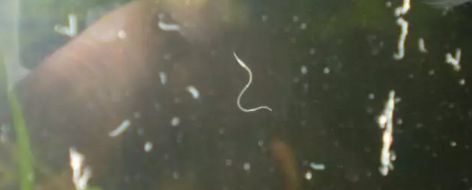
“Detritus worms” are found in virtually all aquariums. They are typically small long white worms which wiggle about in the substrate. They are very beneficial to the aquarium and should just be left alone. Too many detritus worms indicates one is over feeding. Read on if you are interested in being bored.
Detritus Worms in Depth
“Detritus worms” are not a “scientific name”. The term is instead a “common name”. “Detritus worms” are by definition simply ANY “WORM” which lives in the DETRITUS of an aquarium or an aquarium filter. These “worms” can come from many different animal phylums that are in no way related. There are thousands of species, colors and sizes.
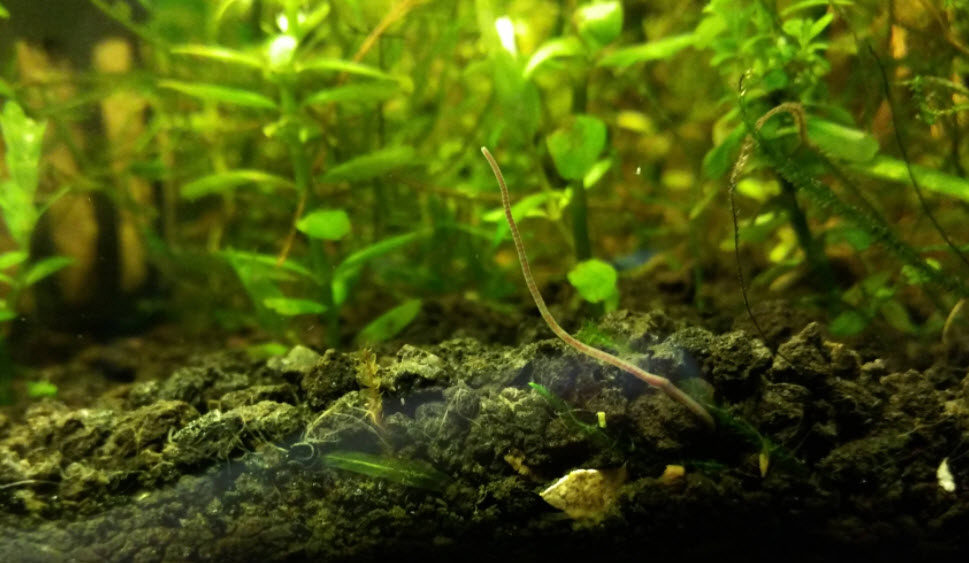
There was a social media commentator who said “Detritus worms are only small thin white worms. Anything else is not a detritus worm“. This is another example of the danger of social media. The commentator asserts this claim with great certainty but is probably copying what was stated authoritatively somewhere else on social media. And that source didn’t do quality research … except to copy what was found on yet another site on social media…
Most “detritus worms” in the aquarium are tubeworms (annelida) related to earthworms and move through the substrate just like small, white, very thin 3/16 inch earthworms. They have earthworm-like bodies that are round in cross-section (not flattened). Their bodies can expand and contract just like earthworms. Upon occasion they will be found writhing in the water column. These are the most common form of “detritus worms” but certainly not the “only” type of detritus worms.
Note there are tens of thousands of species of annelid freshwater “detritus worms” so there can be some very unusual species. They range from 0.25 inch (one mm) to two inch (50 mm) long. They can be white, brown, black or red.
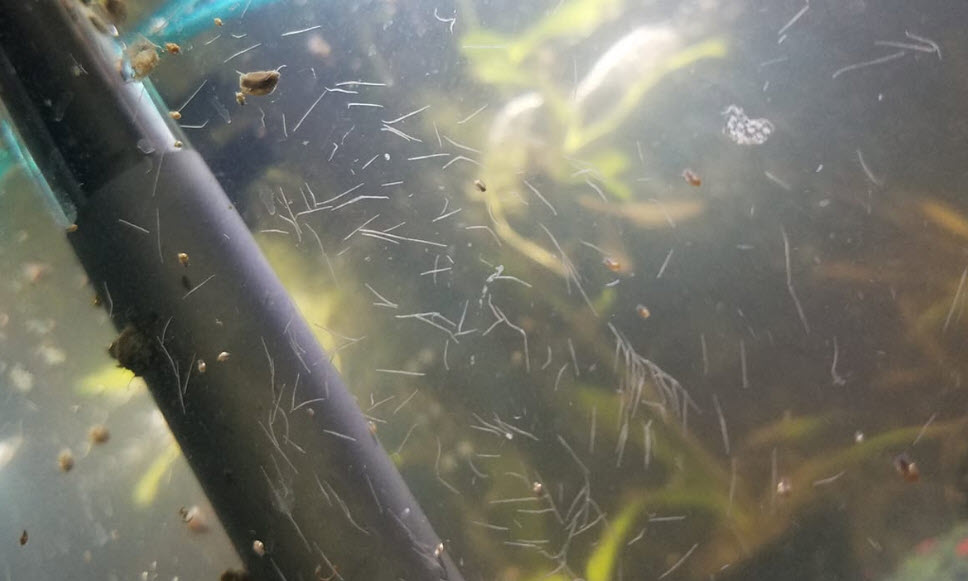
Common Fact About All Detritus Worms
Virtually all detritus worms are actually beneficial to the ecology of an aquarium. Detritus worms eat things like feces and uneaten food. When they do that they considerably reduce organic load in the aquarium. This in turn reduces the stress on the fish.
Detritus worms come into aquariums as hitchhikers on plants and sometimes fish. Most aquariums have detritus worms. They just go unnoticed in the substrate or filter media. Sometimes, if the population explodes for some reason, the oxygen content of the water in the substrate or filter media will drop (or vice versa) and the detritus worms will swim free in the water column by the hundreds. This generally results in a panic by the novice fish keeper.
If you find hundreds of detritus worms floating about your aquarium don’t be alarmed. They won’t hurt anything. They do not reduce the oxygen content of the water. They also will not increase the ammonia level in the tank. Fish will eat them. Just don’t feed your fish for a few days. Hundreds of detritus worms typically indicate either feeding too much or a substrate which is too large. Substrate larger than 5 mm or 0.2 inch can trap food where fish can’t get to it to eat it. And the detritus worms can get to the food.
One thing which occasionally happens with larger detritus worms is that a fish dies and settle to the bottom. Large detritus worms can then crawl out of the substrate and start feeding on the dead fish by latching on to the skin of the fish. And the hobbyist will come on social media with a picture of a long worm attached to a fish. The hobbyist will then ask something along the lines of “what is this worm crawling out of my dead fish?”
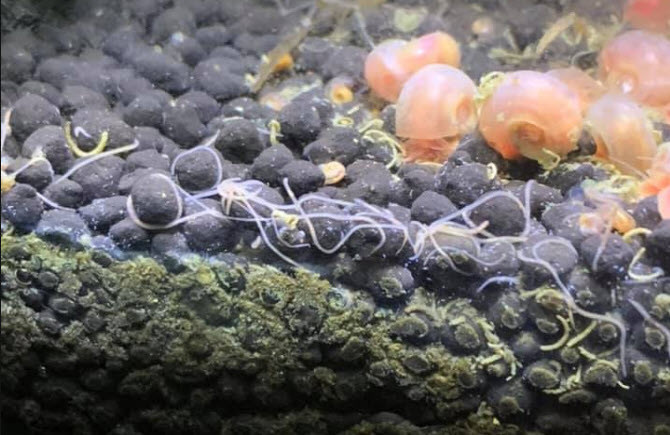
Red or Brown Worms
Often times people find reddish or reddish brown worms in their tank and panic because they think they have camallanus or capillaria, nematode worms which are killers of some fish. If the worms are moving they are harmless detritus worms and not camallanus or capillaria.
Pathogenic worms such as capillaria and camallanus are only found in the fish unless they have been paralyzed with a medication. If they have been paralyzed they will be found motionless on the substrate. Camallanus or capillaria worms are nematodes; their bodies are relatively slender and featureless, and the only free-living life stage is microscopically small. They do not move about the aquarium or swim through the water. So one should not suspect pathogens if one sees long thin brown worms moving in the aquarium.
There are many types of living and moving red or brown annelida worms found in the aquarium. They are all harmless to fish. Think of them as small water living earthworms (which is precisely what they are!).
Tubeworms
Sometimes ugly brown stationary tubes show up on the plants or on the substrate. These tubes are made by small worms which live in the tubes. Occasionally long white worms will extend their bodies out of these tubes.
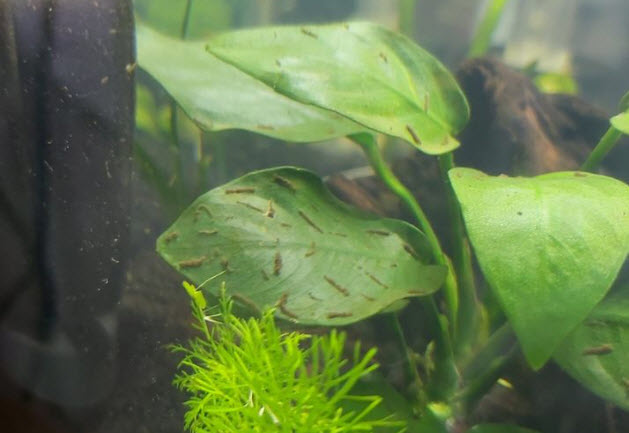
These tubes are created from detritus by a type of detritus annelid worm called a “tubifex” or “naidid” worm (Phylum: Annelida, Family: Naididae, Genus: Tubifex). They feed on decaying organic matter by extending their front ends from their tubes. Some folks call them sludge or sewage worms. They are ugly but harmless.
Brown “Detritus Worms”
In some aquariums there can be found aggregations of long, straight, brown worms. These are worms are probably just tubifex worms. They indicate a seriously overfed tank.
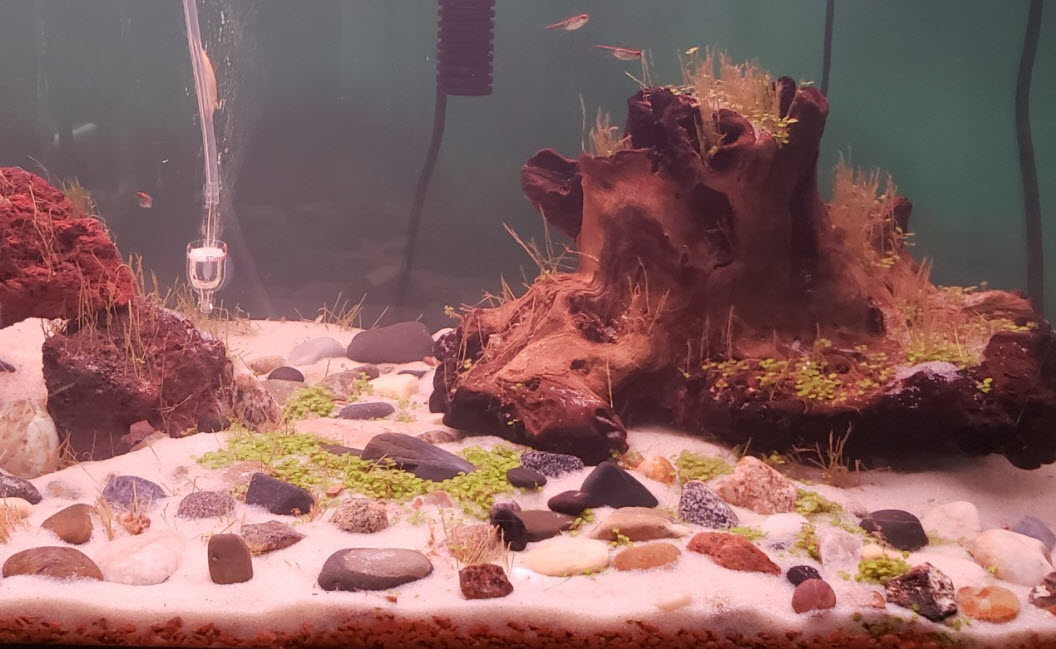
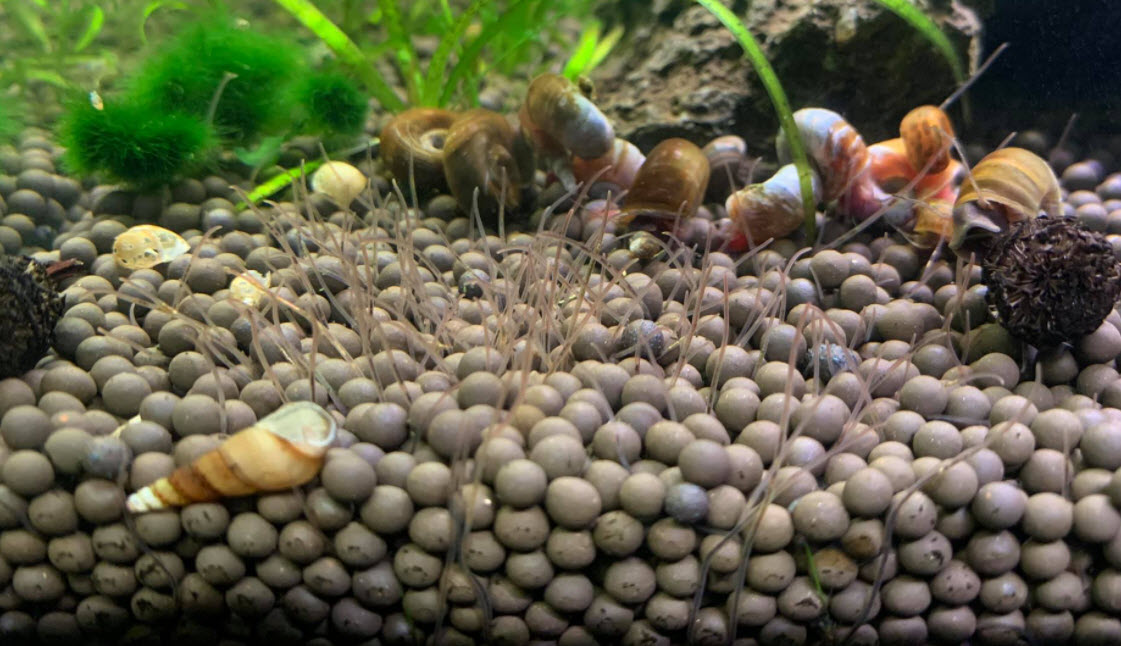

These reddish brown tubifex worms can also be sometimes found in large numbers in the aquarium filter and come out during cleaning of the filter. Typically these worms once again cause panic in the novice fish keeper. These worms are harmless.

Other Types of “Detritus Worms”
Rarely one will find some “detritus worms” which are tubeworms (annelida) but which are leeches. These worms are slightly fatter than “normal” detritus worms and move by inching over the substrate, tail-head-tail-head, contracting and expanding.
Microscopic examination of some “detritus worms” show that they are actually roundworms (phylum nematodes), not tubeworms. A very few “detritus worms” are types of flatworms (phylums planaria or rhabdocoelas). The distinctions is only important to a scientist as almost all types of small “detritus worms” are harmless to fish and shrimp. The only exception is planaria in a shrimp aquarium. Planaria are very efficient, secretive, night time killers of juvenile shrimp. They are a frequent cause of shrimp failing to reproduce. All shrimp aquariums should be treated with fenbendazole or praziquantel to eliminate all flatworms.

Treatment of Detritus Worms
Treating detritus worms is not recommended. They are a natural part of the miniature ecosystem in any aquarium. They are beneficial and any eradication effort will only harm the aquarium. Just treat the underlying issue by either reducing feeding and/or changing the substrate.
If one is determined to eliminate the worms you can use chemical treatments. Fenbendazole and copper are the only two treatments which normally work on most detritus worms.

Note that the cautions about deaths of snails, shrimp and invertebrates is very dose dependent. Fenbendazole is often used with no snail or shrimp deaths because the dosage isn’t high enough. Conversely using a very high dosage of fenbendazole can possibly kill shrimp. And Levamisole is safe for everything except nematodes. Praziquantel is safe with everything except planaria and flukes. But copper WILL kill shrimp at any reasonable dosage.
“Bloodworms”
Most “bloodworms” are the larvae of a chironomid midge fly. A midge is a type of fly that looks somewhat similar to a mosquito. Midge bloodworms have a distinct head capsule, mandibulate jaws, clear segmentation along the body, and often a single proleg (like the ones along the underside of a caterpillar) sort of just under the throat. Midge bloodworms also sometimes have a few small tentacle-like growths near the end of the abdomen.
Midge fly bloodworms cannot expand and contract their bodies like annelid detritus worms so they are easily distinguished from reddish brown annelid detritus worms.
Bloodworms are a very good frozen or fresh food to feed all fish. Note that there is a myth that bloodworms cause bloat. This is a myth.
Sometimes, if one is feeding one’s fish live bloodworms, some of them will escape the fish and can be found living as detritus worms in the substrate.

Note that some rare detritus annelid worms have hemoglobin in their blood and are bright red. These are sometimes called “bloodworms”. They do not have heads or any legs and look just like small red earthworms.
Note that in a shrimp tank some long thin white worms show up occasionally on the substrate which are the adult form of parasitic “horse hair worms”. These are a type of nematode. In ghost shrimp the worms will often be seen inside the shrimp as coiled white strands. The shrimp seem to be fine! These parasites can be treated with Levamisole or Fenbendazole in the shrimp food.
For more information on pests in the aquarium click on this link:
10.13. Pests in the Aquarium
.
Return to Diseases Menu
.
Aquarium Science Website
The chapters shown below or on the right side in maroon lead to close to 400 articles on all aspects of keeping a freshwater aquarium. These articles have NO links to profit making sites and are thus unbiased in their recommendations, unlike all the for-profit sites you will find with Google. Bookmark and browse!
.

Jessica Gazon says
Hello, sorry to bother again! I’ve been dosing all the tanks with PraziPro and sadly the rhabdacoelas do not seem affected. You mentioned slowly—is there any particular reason? Or is there any other method to eradicate them? I haven’t even seen a population drop thus far.
Dave says
In reply to Jessica …. Prazipro ONLY kills flatworms (tapeworms and flukes). It won’t harm detritus worms or tubifex worms.
Jessica says
Upon adding it, it *seems* like most of the Tubifex started wriggling immediately, presumably as a reaction to the Prazipro. But I’d still love to hear your thoughts if you disagree!
Jessica says
Thank you for your reply! I’ve bought Prazipro and am wondering…will it hurt “detritus worms”? I believe I have Tubifex worms, they’re long, thin, and orange, have little spikes per segment, and stick their head out of the gravel. When disturbed they sometimes start wriggling frantically to get to the top. This is for a very small tank with a one shrimp pair, only 1.75 gal, so I’m worried that the Tubifex deaths will overwhelm the tank with ammonia. A lot of places on the internet say they kill *all* worms but I don’t believe that’s true so I wanted to check in case I misunderstood. Thank you again!
Dave says
In reply to Jessica ……. Rhabdocoelas are slowly taken care of by Prazipro in the water. It shouldn’t affect either the snails or the shrimp.
Jessica Gazon says
Any suggestions for getting rid of Rhabdocoelas? I’m trying to breed bladder snails and Ramshorns in my shrimp tank but the Rhabs are eating their eggs and the babies (I used to see tiny shells everywhere). The snails eventually stopped breeding altogether. I’ve been trying manual removal but it hasn’t really been helping.
I will say, I did notice detritus worms (the annelids, the ones that move like little snakes) popping up in one of those tanks suddenly and I haven’t been seeing many Rhabs since then. I have no idea why. But even there the bladders never started breeding again. Please help!
Dave says
In reply to Elise … Probably just a type of earthworm that came in with the soil. Nothing to worry about.
Elise says
I had worms turn up during my cycle. Dirted tank, topped with white silica sand. Natural uncleaned rock and wood. They turned up before plants were added, have a bulbus head, are stripey, about 8mm long and are round. They sit on top of the substrate and just wiggle. A lot! Haha.
Do you know what type of worm they are? And would they have come in with the dirt/rock/wood?
Anonymous says
Thanks for clearing this subject up for me. I was thinking they might be harmful to my breeding guppies , but now I know that they are just new friends. Beauty is not a prerequisite for citizenship in my tank. Welcome, and work hard to clean up after my tendency to over feed.
Anonymous says
Very interesting read..